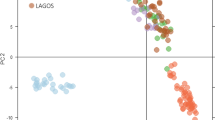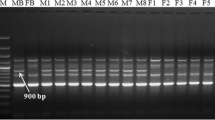Abstract
Buffalograss, Buchloe dactyloides (Nutt.) Engelm, is a dioecious turfgrass native to the Great Plains of North America. Since its naturalization, it has become the most wildly cultivated warm-season turfgrass in northern China. While dioecious plants represent only a small proportion of all plant species, they are important models in the study of plant sex determination and evolution. The identification of the sexes is important in the theory and practice of breeding programs. At present, there is no effective method to determine the sex of early stage buffalograss. The objective of this study was to use sequence-related amplified polymorphism (SRAP) and integrated bulked segregant analysis (BSA) technology to find sex linked markers in B. dactyloides. A total of 228 primer combinations were screened and 2,690 SRAP bands examined. Only ME9/EM2 could generate a specific fragment (~240 bp) in all the female plants, which was absent in male plants. The methods described here provide a simple and reproducible means of early sex identification in B. dactyloides.




Similar content being viewed by others
References
Alstrom-Rapaport C, Lascoux M, Wang YC et al (1998) Identification of a RAPD marker linked to sex determination in the basket willow (Salix viminalis L.). J Hered 89(1):44–48
Beard JB (1973) Turfgrass: science and culture. Prentice-Hall, Englewood Cliffs
Beetle AA (1950) Buffalograss-native of the shortgrass plains. Univ Wyoming Agric Exp Stn Bull 293:1–31
Budak H, Shearman RC, Parmaksiz I et al (2004a) Molecular characterization of buffalo grass germplasm using sequence-related amplified polymorphism markers. Theor Appl Genet 108(2):328–334
Budak H, Shearman RC, Gaussoin RE et al (2004b) Application of sequence-related amplified polymorphism markers for characterization of turfgrass species. Hortscience 39(5):955–958
Budak H, Shearman RC, Parmaksiz I et al (2004c) Comparative analysis of seeded and vegetative buffalograsses based on pylogenetic relationship using ISSR, SSR, RAPD and SRAP. Theor Appl Genet 109:280–288
Budak H, Shearman RC, Gulsen O et al (2005) Understanding ploidy complex and geographic origin of the Buhcloe dactyloides genome using cytoplasmic and nuclear marker system. Theor Appl Genet 111:1545–1552
Chaves-Bedoya G, Nunez V (2007) A SCAR marker for the sex types determination in Colombian genotypes of Carica papaya. Euphytica 153(1/2):215–220
Cheplick GP (1998) Population biology of grasses. Cambridge University Press, Cambridge, pp 136–138
Cristiana Moliterni VM et al (2004) The sexual differentiation of Cannabis sativa L.: a morphological and molecular study. Euphytica 140:95–106
Deputy JC, Ming R, Ma H et al (2003) Molecular markers for sex determination in papaya (Carica papaya L.). Theor Appl Genet 106(1):107–111
Ferriol M, Pico B, Nuez F (2003) Genetic diversity of a germplasm collection of Cucurbita pepo using SRAP and AFLP markers. Theor Appl Genet 107:271–282
Gao WJ, Li R, Li L et al (2007) Identification of two markers linked to the sex locus in dioecious Asparagus officinalis plants. Russ J Plant Physiol 54(6):816–821
Gill GP, Harvey CF, Gardner RC et al (1998) Development of sex-linked PCR markers for gender identification in Actinidia. Theor Appl Genet 97(3):439–445
Gunter LE, Roberts GT, Lee K et al (2003) The development of two flanking SCAR markers linked to a sex determination locus in Salix viminalis L. J Hered 94(2):185–189
Hitchcock AS (1951) Manual of the grasses of the United States, 2nd edn. US Department of Agriculture, Misc Publication 200, Washington
Hormaza JI, Dollo L, Polito VS (1994) Identification of a RAPD marker linked to sex determination in Pistacia vera using bulked segregant analysis. Theor Appl Genet 89(1):9–13
Huff DR, Wu L (1987) Sex expression in buffalograss under different environments. J Crop Sci 27:623–626
Huff DR, Wu L (1992) Distribution and inheritance of inconstant sex forms in natural populations of dioecious buffalograss (Buchloe dactyloides). Am J Bot 79:207–215
Jiang C, Sink KC (1997) RAPD and SCAR markers linked to the sex expression locus M in asparagus. Euphytica 94:329–333
Khadka DK, Nejidat A, Tai M et al (2002) DNA markers for sex: molecular evidence for gender dimorphism in dioecious Mercurialis annua L. Mol Breed 9:251–257
Korpelainen H (2002) A genetic method to resolve gender complements investigations on sex ratios in Rumex acetosa. Mol Ecol 11(10):2151–2156
Lemos EGM, Silva CLSP, Zaidan HA (2002) Identification of sex in Carica papaya L. using RAPD markers. Euphytica 127(2):179–184
Li G, Quiros CF (2001) Sequence-related amplified polymorphism (SRAP), a new marker system based on a simple PCR reaction: its application to mapping and gene tagging in Brassica. Theor Appl Genet 103:455–461
Li G, Gao M, Yang B, Quiros CF (2003) Gene for gene alignment between the Brassica and Arabidopsis genomes by direct transcriptome mapping. Theor Appl Genet 107:168–180
Liang CAI, Xiaocheng TIAN, Ming LI et al (2002) Application of RAPD in discrimination of Podocarpus macrophyllus’s sex. J Fudan Univ 41(6):635–640
Liao L, Liu J, Dai Y et al (2009) Development and application of SCAR markers for sex identification in the dioecious species Ginkgo biloba L. Euphytica 169:49–55
Lin Z, Zhang X, Nie Y et al (2003) Construction of a genetic linkage map for cotton based on SRAP. Chin Sci Bull 48(19):2063–2067
Mandolino G, Carboni A, Forapani S et al (1998) Identification of DNA markers linked to the male sex in dioecious hemp (Cannabis sativa L.). Theor Appl Genet 98(1):86–92
Masayuki M (2009) Development of SCAR markers for sex determination in the dioecious shrub Aucuba japonica (Cornaceae). Genome 52:231–237
Ming R, Moore PH (2007) Genomics of sex chromosomes. Curr Opin Plant Biol 10:123–130
Mulcahy DL, Weeden NF, Kesseli et al (1992) DNA probes for the Y-chromosome of Silene latifolia, a dioecious angiosperm. Sex Plant Reprod 5(1):86–88
Niu JZ (2006) Study on the selection of cultivar, clonal growth and mechanism of resource translocating between Clonal Ramets of Buffalograss (Buchloe dactyloides). Dissertation for Master’s Degree, China Agricultural University
Paran I, Michelmore RW (1993) Development of reliable PCR-based marker linked to Downey mildew resistant genes in lettuce. Theor Appl Genet 85:985–993
Parasnis AS, Ramakrishna W, Chowdari KV (1999) Mierosatellite (GATA) n reveals sex-specific differences in PaPaya. Theor Appl Genet 99(6):1047–1052
Parasnis AS, Gupta VS, Tamhankar SA et al (2000) A highly reliable sex diagnostic PCR assay for mass screening of papaya seedlings. Mol Breed 6(3):337–344
Parker JS (1990) Sex chromosomes and sexual differentiation in flowering plants. Chromosom Today 10:187–198
Parrish TL, Koelewijn HP, van Dijk PJ (2004) Identification of a male-specific AFLP marker in a functionally dioecious Ficus fulva. Sex Plant Reprod 17:17–22
Prakash S, Staden JV (2006) Sex identification in Encephalartos natalensis (Dyer and Verdoorn) using RAPD markers. Euphytica 152:197–200
Reamon-Buttner SM, Jung C (2000) AFLP-derived STS markers for the identification of sex in Asparagus officinalis L. Theor Appl Genet 100:432–438
Reeder JR (1971) Notes on Mexican grasses. IX. Miscellaneous chromosome numbers. Brittonia 23:105–117
Ren C-X, Huang J, Chang XY et al (2007) RAPD and SCAR molecular markers for male trait in Carica papaya. J Fruit Sci 24(1):72–75
Roodt R, Spies JJ, Burger TH (2002) Preliminary DNA finger-printing of the turfgrass Cynodon dactylon (Poaceae: Cloridoideae). Bothalia 32:117–122
Ruas CF, Fairbanks DJ, Evans RP et al (1998) Male-specific DNA in the dioecious species Atriplex garrettii (Chenopodiaceae). Am J Bot 85(2):162–197
Saghai-Maroof MA, Soliman KM, Jorgensen RA et al (1984) Ribosomal DNA spacer-length polymorphisms in barely: ribosomal inheritance, chromosomal location, and population dynamics. Proc Natl Acad Sci USA 81(24):8014–8018
Shao MJ (1998) Breeding of new variety of buffalograss. The Temple of Heaven. Beijing (unpublished data)
Stilio VS, di Kesseli RV, Mulcahy DL (1998) A pseudo autosomal random amplified polymorphic DNA marker for the sex chromosomes of Silene dioica. Genetics 149(4):2057–2062
Tang DM, Luo SP, Li J et al (2003) Sex identification of pistachio by using RAPD analysis. J Fruit Sci 20(2):124–126
Torjek O, Bucherna N, Kiss E et al (2002) Novel male-specific molecular markers (MADC5, MADC6) in hemp. Euphytica 127(2):209–218
Urasaki N, Tokumoto M, Tarora K et al (2002) A male and hermaphrodite specific RAPD marker for papaya (Carica papaya L.). Theor Appl Genet 104:281–285
Vyskot B, Hobza R (2004) Gender in plants: sex chromosomes are emerging from the fog. Trends Genet 20:432–438
Xu WJ, Wang BW, Cui KM (2004) RAPD and SCAR markers linked to sex determination in Eucommia ulmoides Oliv. Euphytica 136:233–238
Yakubov B, Barazani O, Golan-Goldhirsh A (2005) Combination of SCAR primers and touch-down PCR for sex identification in Pistacia vera L. Sci Hortic 103(4):473–478
Yampolsky C, Yampolsky H (1922) Distribution of sex forms in the phanerogamic flora. Bibl Genet 3:1–62
Yanan H, Fenglan L, Shumin G (2004) Sex determination and sexual organ differentiation in flowering plants. For Stud China 4(6):51–57
Yao CC, Wang YJ, Liu XF et al (2005) Obtainment and application of RAPD marker S1032–850 linked to male gene in Actinidia. J Agric Biotechnol 13(5):557–561
Zeng B, Zhang XQ, Lan Y et al (2008) Evaluation of genetic diversity and relationships in orchardgrass (Dactylis glomerata L.) germplasm based on SRAP markers. Can J Plant Sci 88(1):53–60
Zheng L, Junsong P, Yuan G et al (2008) Development and fine mapping of three codominant SCAR markers linked to the M/m gene in the cucumber plant (Cucumis sativus L.). Theor Appl Genet 117:1253–1260
Zheng C, Zhu X, Fang L et al (2009) Analysis of sex and strains of Ficus awkeotsang Makino by SRAP. Chin J Trop Crops 12(30):1740–1745
Acknowledgments
This study was supported by National Natural Science Foundation of China (30800799).
Author information
Authors and Affiliations
Corresponding author
Rights and permissions
About this article
Cite this article
Zhou, Yj., Wang, Xg. & Zhang, Xq. Development and application of a SRAP marker for the identification of sex in Buchloe dactyloides . Euphytica 181, 261–266 (2011). https://doi.org/10.1007/s10681-011-0419-9
Received:
Accepted:
Published:
Issue Date:
DOI: https://doi.org/10.1007/s10681-011-0419-9




